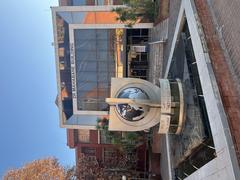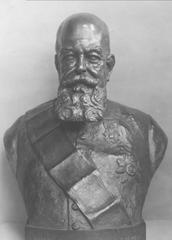
National Women’s Monument Bloemfontein: Complete Guide to Visiting Hours, Tickets, and Historical Significance
Date: 04/07/2025
Introduction
The National Women’s Monument (Nasionale Vrouemonument) in Bloemfontein stands as a powerful testament to the resilience, suffering, and sacrifice of nearly 27,000 Boer women and children who lost their lives in British concentration camps during the Anglo-Boer War (1899–1902). Conceived in the wake of immense national trauma, the monument is both a solemn memorial and a vital symbol of South African heritage. This comprehensive guide covers the monument’s history, design, visiting information—including hours, tickets, and accessibility—travel tips, nearby attractions, and practical advice to help you make the most of your visit.
Historical Context and Monument Origins
The National Women’s Monument was initiated by President Martinus Theunis Steyn and his wife, Rachel Isabella Steyn, shortly after the war. Their vision was to create a memorial that would honor the memory of the thousands of women and children who died in the British-run concentration camps. The project became a grassroots effort, funded by small donations from Afrikaner, Jewish, and English communities, reflecting a spirit of unity in the aftermath of conflict (Vrouemonument Official Site, SA History Online).
Unveiled in 1913, the monument’s emotive design and symbolic features were created to foster remembrance and reconciliation, marking a turning point in South Africa’s collective memory.
Architectural Design and Artistic Vision
The monument was designed by architect Frans Soff and renowned sculptor Anton van Wouw, whose approach blended symbolism with realism. The central feature is a 36.5-meter (120-foot) high granite obelisk, flanked by semi-circular sandstone walls. At the base, Van Wouw’s bronze sculptures depict a grieving mother and child, evoking compassion and empathy for those who suffered (Lonely Planet, artefacts.co.za).
Additional features include:
- Bas-relief panels: Illustrate scenes of suffering in the camps.
- Memorial stones: Forty-four stones line the approach, each representing a concentration camp.
- Burial sites: The monument is also the final resting place of Steyn, Emily Hobhouse, and other key figures, linking personal stories to national history (historyhit.com).
Inscriptions in Afrikaans and English, along with symbolic elements like the Bittereinder Gate and Great Trek wagon tracks, reinforce the monument’s message of endurance and remembrance (Vrouemonument Official Site).
Integration with the War Museum of the Boer Republics
Adjacent to the monument is the War Museum of the Boer Republics, which offers extensive exhibits, artifacts, and audiovisual materials contextualizing the Anglo-Boer War and the suffering of civilians. The proximity of the museum enhances your understanding of the events commemorated by the monument (wheretostay.co.za).
Visiting Information
Location and Access
- Address: Intersection of Markgraaff and Nelson Mandela Drive, Bloemfontein, Free State.
- Getting There: The site is easily accessible by car or taxi, with ample signage from major routes. Public transport options are limited.
- Parking: On-site parking is available for cars and buses. Wheelchair-accessible spaces are provided.
Visiting Hours
- Monday–Saturday: 09:00–17:00
- Sundays & Public Holidays: 10:00–17:00
- Note: Hours may vary on public holidays or for special events. Always check the official website before your visit.
Tickets and Entry Fees
- Monument Grounds: Admission is generally free.
- War Museum: Ticketed entry, with prices as of 2025:
- Adults: ZAR 50
- Children/Students: ZAR 20
- Pensioners: Discounted rates
- Group rates available
- Purchase: Tickets can be bought at the entrance. Online sales are limited.
Guided Tours
- Availability: Guided tours (available in English and Afrikaans) can be booked through the War Museum’s visitor center or by prior arrangement.
- Duration: 60–90 minutes
- Content: Focus on the monument’s history, symbolism, and personal stories of those commemorated.
Accessibility
- Wheelchair Access: Paved pathways, ramps, and accessible restrooms throughout the site.
- Facilities: Café, gift shop, picnic areas, and accessible parking.
- Assistance: Staff are available to assist visitors with special needs; guide dogs are permitted.
Practical Visitor Tips
- Best Time to Visit: Early mornings or late afternoons for softer light and fewer crowds.
- Dress Code: Comfortable walking shoes, sun protection, and water are recommended, especially in summer.
- Photography: Permitted throughout the grounds, but flash is restricted inside the museum. Be respectful near gravesites and during ceremonies.
- Etiquette: Maintain quiet, respectful behavior, particularly in the monument area and during commemorative events.
Nearby Attractions
- Anglo-Boer War Museum: Adjacent to the monument, with comprehensive war exhibits.
- Oliewenhuis Art Museum: Showcasing South African art.
- Fourth Raadsaal: Historical government building.
- Free State National Botanical Garden: For nature lovers.
- Accommodation: Range of guesthouses and hotels nearby, especially in the suburb of General De Wet (LekkeSlaap).
The Monument’s Enduring Legacy
The National Women’s Monument is more than a historical landmark—it is an active site of remembrance, education, and cultural reflection. Annual events, such as Women’s Day ceremonies, bring communities together to honor the experiences of women and children during war. The monument’s design and symbolism have influenced memorial art across South Africa and serve as a reminder of the universal costs of conflict (en.wikipedia.org, Rovos Rail).
Frequently Asked Questions (FAQ)
Q: What are the visiting hours for the National Women’s Monument?
A: Monday–Saturday, 09:00–17:00; Sundays and public holidays, 10:00–17:00. Check the official website for updates.
Q: Is there an entrance fee or are tickets required?
A: Entry to the monument grounds is free. The War Museum charges a modest fee (adults ZAR 50; children/students ZAR 20).
Q: Are guided tours available?
A: Yes; book through the War Museum visitor center or in advance.
Q: Is the site wheelchair accessible?
A: Yes; paved paths, ramps, and accessible restrooms are provided.
Q: Are cameras allowed?
A: Photography is encouraged outdoors; flash is restricted inside the museum.
Q: Can I buy tickets online?
A: Most ticket sales are on-site; arrive early during busy times.
Visual and Interactive Resources
High-quality images and a virtual tour are available on the official website, offering a preview of the monument’s architecture and grounds. These resources are optimized with descriptive alt text for accessibility and search engine visibility.
Internal Links
External Links
- SA History Online: National Women’s Monument
- Vrouemonument Official Site
- Lonely Planet: National Women’s Memorial
- Artefacts.co.za Monument Page
- Rovos Rail National Women’s Monument
- Women’s Memorial Bloemfontein Resource
- Evendo Event Listings
- LekkeSlaap Attraction Guide
- History Hit Monument Overview
- Wheretostay.co.za Article
- Wanderwomenproject.com Place Page
- Wikipedia Page
Conclusion
The National Women’s Monument in Bloemfontein is a site of profound remembrance, reflection, and education—honoring the sacrifices and resilience of South African women and children during the Anglo-Boer War. Its evocative design, meaningful inscriptions, and integration with the War Museum provide a deeply moving experience for all visitors. With easy access, comprehensive facilities, and a wealth of historical and artistic significance, the monument is essential for anyone interested in South Africa’s complex past.
For the best experience, plan your visit with the help of this guide, and consider downloading the Audiala app for audio tours and additional historical content. Stay updated by following official channels and social media for upcoming events and heritage insights.




